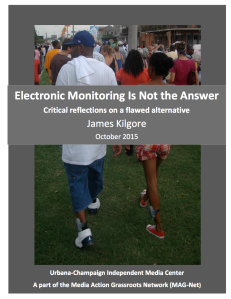 On February 19, 2014, the European Union’s Committee of Ministers adopted a set of recommendations on electronic monitoring. These represent a major step forward in carving out specific rights for the monitored as well as in re-framing monitoring in a less punitive fashion. US jurisdictions have much to learn from this document. The crucial sections are pasted in below.
On February 19, 2014, the European Union’s Committee of Ministers adopted a set of recommendations on electronic monitoring. These represent a major step forward in carving out specific rights for the monitored as well as in re-framing monitoring in a less punitive fashion. US jurisdictions have much to learn from this document. The crucial sections are pasted in below.
III. Basic principles
1. The use, as well as the types, duration and modalities of execution of electronic monitoring in the framework of the criminal justice shall be regulated by law.
2. Decisions to impose or revoke electronic monitoring shall be taken by the judiciary or allow for a judicial review.
3. Where electronic monitoring is used at the pre-trial phase special care needs to be taken not to net-widen its use.
4. The type and modalities of execution of electronic monitoring shall be proportionate in terms of duration and intrusiveness to the seriousness of the offence alleged or committed, shall take into account the individual circumstances of the suspect or offender and shall be regularly reviewed.
5. Electronic monitoring shall not be executed in a manner restricting the rights and freedoms of a suspect or an offender to a greater extent than provided for by the decision imposing it.
6. When imposing electronic monitoring and fixing its type, duration and modalities of execution account should be taken of its impact on the rights and interests of families and third parties in the place to which the suspect or offender is confined.
7. There shall be no discrimination in the imposition or execution of electronic monitoring on the grounds of gender, race, colour, nationality, language, religion, sexual orientation, political or other opinion, national or social origin, property, association with a national minority or physical or mental condition.
8. Electronic monitoring may be used as a stand-alone measure in order to ensure supervision and reduce crime over the specific period of its execution. In order to seek longer term desistance from crime it should be combined with other professional interventions and supportive measures aimed at the social reintegration of offenders.
9. Where private sector organisations are involved in the implementation of decisions imposing electronic monitoring, the responsibility for the effective treatment of the persons concerned in conformity with the relevant international ethical and professional standards shall remain with public authorities.
10. Public authorities shall ensure that all relevant information regarding private sector involvement in the delivery of electronic monitoring is transparent and shall regulate the access to it by the public.
11. Where suspects and offenders are contributing to the costs for the use of electronic monitoring, the amount of their contribution shall be proportionate to their financial situation and shall be regulated by law.
12. The handling and shared availability and use of data collected in relation to the imposition and implementation of electronic monitoring by the relevant agencies shall be specifically regulated by law.
13. Staff responsible for the implementation of decisions related to electronic monitoring shall be sufficient in number and adequately and regularly trained to carry out their duties efficiently, professionally and in accordance with the highest ethical standards. Their training shall cover data protection issues.
14. There shall be regular government inspection and avenues for independent monitoring of the agencies responsible for the execution of electronic monitoring in a manner consistent with national law.
IV. Conditions of execution of electronic monitoring at the different stages of the criminal process
1. In order to ensure compliance, different measures can be implemented in accordance with national law. In particular, the suspect’s or offender’s consent and co-operation may be sought, or dissuasive sanctions may be established.
2. The modalities of execution and level of intrusiveness of electronic monitoring at the pre-trial stage shall be proportionate to the alleged offence and shall be based on the properly assessed risk of the person absconding, interfering with the course of justice, posing a serious threat to public order or committing a new crime.
3. National law shall regulate the manner in which time spent under electronic monitoring supervision at pre-trial stage may be deducted by the court when defining the overall duration of any final sanction or measure to be served.
4. Where there is a victim protection scheme using electronic monitoring to supervise the movements of a suspect or an offender, it is essential to obtain the victim’s prior consent and every effort shall be made to ensure that the victim understands the capacities and limitations of the technology.
5. In cases where electronic monitoring relates to exclusion from, or limitation to, specific zones, efforts shall be made to ensure that such conditions of execution are not so restrictive as to prevent a reasonable quality of everyday life in the community.
6. Where substance abuse needs to be monitored, consideration shall be given to the respective intrusiveness and therapeutic and educative potential of electronic and traditional approaches when deciding which approach is to be used.
7. Electronic monitoring confining offenders to a place of residence without the right to leave it should be avoided as far as possible in order to prevent the negative effects of isolation, in case the person lives alone, and to protect the rights of third parties who may reside at the same place.
8. In order to prepare offenders for release, and depending on the type of offence and offender management programme, electronic monitoring may be used to increase the number of individual cases of short-term prison leave that are granted, or to give offenders the possibility to work outside prison or be given a placement in an open prison.
9. Electronic monitoring may be used as an alternative execution of a prison sentence, in which case its duration shall be regulated by law.
10. Electronic monitoring may be used, if needed, in case of early release from prison. In such a case, its duration shall be proportionate to the remainder of the sentence to be served.
11. If electronic monitoring is used, if needed, after the prison sentence has been served, as a post-release measure, its duration and intrusiveness shall be carefully defined, in full consideration of its overall impact on former prisoners, their families and third parties.
I. Ethical issues
1. Age, disability and other relevant specific conditions or personal circumstances of each suspect or offender shall be taken into account in deciding whether and under what modalities of execution electronic monitoring may be imposed.
2. Under no circumstances may electronic monitoring equipment be used to cause intentional physical or mental harm or suffering to a suspect or an offender.
3. Rules regarding the use of electronic monitoring shall be periodically reviewed in order to take into account the technological developments in the area so as to avoid undue intrusiveness into the private and family life of suspects, offenders and other persons affected.
I. Data protection
1. Data collected in the course of the use of electronic monitoring shall be subject to specific regulations based on the relevant international standards regarding storage, use and sharing of data.
2. Particular attention shall be paid to regulating strictly the use and sharing of such data in the framework of criminal investigations and proceedings.
3. A system of effective sanctions shall be put in place in case of careless or intentional misuse or handling of such data.
4. Private agencies providing electronic monitoring equipment or responsible for supervising persons under electronic monitoring shall be subjected to the same rules and regulations regarding handling of the data in their possession.
I. Staff
1. All relevant rules of Recommendation Rec(92)16 on the European rules on community sanctions and measures, of Recommendation Rec(97)12 on staff concerned with the implementation of sanctions and measures, of RecommendationCM/Rec(2010)1 on the Council of Europe Probation Rules and of Recommendation CM/Rec(2012)5 on the European Code of Ethics for Prison Staff, which relate to staff, shall be applicable.
2. Staff shall be trained to communicate sensitively with suspects and offenders, to inform them in a manner and language they understand of the use of the technology, of its impact on their private and family lives and on the consequences of its misuse.
3. Staff shall be trained to deal with victims in cases where victim support schemes are used in the framework of electronic monitoring.
4. In establishing electronic monitoring systems, consideration shall be given to the respective merits of both human and automated responses to the data gathered by the monitoring centre, bearing in mind the advantages of each.
5. Staff entrusted with the imposition or execution of electronic monitoring shall be regularly updated and trained on the handling, use and impact of the equipment on the persons concerned.
6. Staff shall be trained to install and uninstall technology and provide technical assistance and support in order to ensure the efficient and accurate functioning of the equipment.
I. Work with the public, research and evaluation
1. The general public shall be informed of the ethical and technological aspects of the use of electronic monitoring, its effectiveness, its purpose and its value as a means of restricting the liberty of suspects or offenders. Awareness shall also be raised regarding the fact that electronic monitoring cannot replace professional human intervention and support for suspects and offenders.
2. Research and independent evaluation and monitoring shall be carried out in order to help national authorities take informed decisions regarding the ethical and professional aspects of the use of electronic monitoring in the criminal process.
 This article by Julie Morse for the Pacific Standard summarizes some interesting research by UC Berkeley Law Professor Kate Weisburd. She did work on the use of electronic monitoring with juveniles in California and found that in many cases it failed to save money, was extremely punitive and often landed young people back behind bars. She calls for a re-think of the legal status of EM as well. Very thought-provoking and great to see that some legal scholars are now looking at this through a lens other than recidivism. Now we just need to deepen the dialog about the “rights of the monitored.”
This article by Julie Morse for the Pacific Standard summarizes some interesting research by UC Berkeley Law Professor Kate Weisburd. She did work on the use of electronic monitoring with juveniles in California and found that in many cases it failed to save money, was extremely punitive and often landed young people back behind bars. She calls for a re-think of the legal status of EM as well. Very thought-provoking and great to see that some legal scholars are now looking at this through a lens other than recidivism. Now we just need to deepen the dialog about the “rights of the monitored.”





